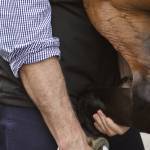Hock Problems in Horses

Bog spavin, bone spavin, curb, thoroughpin, capped hock…a host of problems can occur in this important joint in a horse’s hind leg. Because the horse derives power from the hindquarters, any problem involving the hocks has a good probability of being serious. Some of these conditions were seen more commonly in past eras when horses were driven instead of ridden, though they can still be found in today’s equines. Some are related to defects in skeletal structure, while others are caused by strain or overuse.
“Spavin” comes from a root word meaning swelling. In simple terms, a bog spavin is a soft puffiness or swelling at the front of the hock, while a bone spavin is a solid bony enlargement on either side of the hock, often caused by arthritis. Lameness and heat often accompany a bone spavin, while bog spavins usually don’t cause heat or lameness. Despite various causes, spavin is usually an indication of poor or weak hock conformation. Horses with less than ideal conformation may develop bog or bone spavin if they are subjected to hard use, especially on unyielding surfaces. Excessive strain or irritation of the hard or soft hock tissues for any reason, especially if these tissues are weak or poorly supported in some way, can lead to spavin.
Thoroughpin is a soft swelling that can be pushed back and forth across the hollow just above the point of the hock. The swelling is a fluid-filled joint sac that may develop because of the strain of jumping, dressage, or reining when a young or unfit horse is asked for exercise beyond its level of fitness.
A curb, or curby hocks, is a condition resulting from enlargement of the plantar ligament that runs along the back of the hock. This may be seen in horses with malformed hocks in which the small bones in the joint are not aligned properly with the cannon bone in the lower leg. Foals born with “windswept” hind legs that are bent sideways are prone to developing curbs as they mature. A curb usually doesn’t cause lameness but indicates a weakness in the hock that may limit the horse’s ability to perform well for many years.
Of the most common hock problems, capped hocks are probably the least serious as far as lameness, falling into the category of “unsightly but not unsound.” This swelling at the point of the hock may be caused by an injury or kick from another horse, but the most common cause is repeated blows to the hock as the horse kicks its stall or trailer walls. Accumulations of fluid form a “cap” that may reach a quart in volume. Unfortunately, completely reducing the swollen mass is nearly impossible.
How can an owner avoid hock injuries in his horse? First, look very closely at hock conformation in any horse being considered for purchase. Have a veterinarian examine the hocks and the overall suitability of the horse for the proposed discipline. Take training slowly and steadily, being careful not to ask too much too soon from a young or green horse. Avoid overtaxing a horse, especially one that is elderly or fatigued. Don’t work a horse in deep or slippery footing. Protect horses from self-inflicted injury; adequate turnout at home and shipping boots for trips will help with this management.








